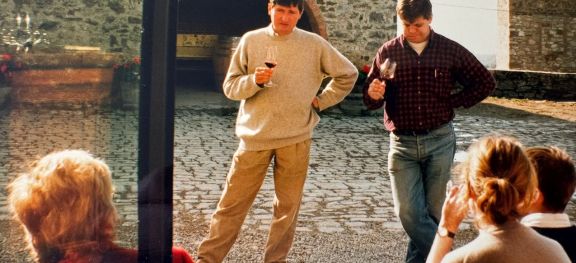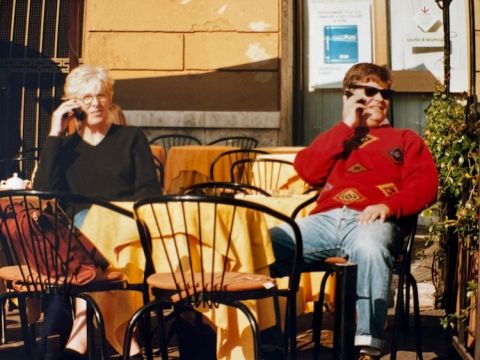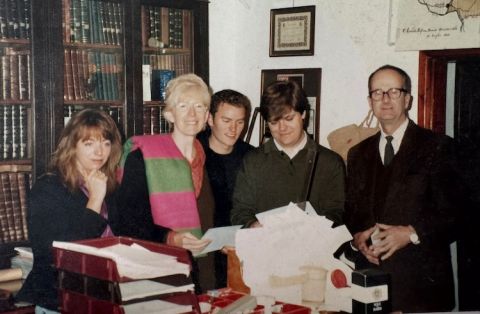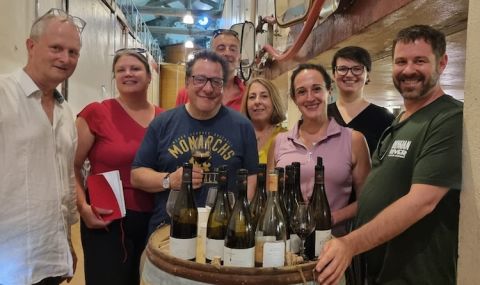Expanding somms' horizons

There's nothing like experiencing a wine region first-hand, as legions of invitees have found. And it does no harm for the hosts either. Above, Paolo De Marchi and David Gleave MW address visitors from the UK hospitality industry at Isole e Olena on an early 'immersion trip'.
It is very rare that one can pinpoint not just the two individuals on either side of the Atlantic responsible for initiating a particularly beneficial practice in hospitality but also precisely when. Step forward Evan Goldstein MS, sommelier and wine educator based in San Francisco, and David Gleave MW, Canadian-born founder of London-based Liberty Wines. The beneficial practice? Taking sommeliers to visit vineyards and wineries to learn more about the wines they are selling. And the year they each, separately, embarked on this: 1990.
Until then this custom did not exist. Wine was a male preoccupation and sommeliers’ knowledge was limited to what they could learn themselves and what importers were willing to tell them. As Goldstein explained, ‘when I was an aspiring, green sommelier back in the mid 1980s, there was no such thing as immersion trips. Not only that, but there was zero mechanism for you to put one together: figuring out where you wanted to go, faxing (there was no internet) requests, and hoping that you received an entrée. I vividly recall asking my suppliers for help when I was unable to navigate the path and intimidating them by suggesting I would kick wines off the list if they could not assist. Moreover there were not so many producers visiting the US then and those that were coming were mostly either French and Italian.’
In 1990, Gleave, then working with Nicolas Belfrage MW at Winecellars in Wandsworth, took, out of friendship, the late Rose Gray and Ruth Rogers, partners in London’s famous River Café, on an eating and drinking trip to Piemonte.
He recalled, ‘It began with a visit to Il Giardino da Felicin in Monforte d’Alba. Aldo Conterno came with us. I remember the owner Giorgio Rocca telling us off for arriving late. Rose was very taken by the pasta – the local tajarin of course – and asked Giorgio what the secret was. “Olio di gomito”, he replied – elbow grease.
‘We went back the following day and he finally told us that the secret was the flour which came from the Sobrino mill in La Morra. We bought two ten-kilo sacks which I put in the back of my car and drove back to London. I got a bit worried approaching the UK Customs with two sacks of white powder in my car but I got through.
‘In 1991 I returned with Rose, her son Ossie Gray and met chef Theo Randall there. On that trip we went to visit olive oil producers like Selvapiana, Capezzana and Fontodi as well as Isole e Olena. They also produce wine and the notion of taking a few sommeliers out to the vineyards developed which has today become a regular occurrence.’
So much so that Gleave is now considered by Robin Davis, the founder of UK wine merchant Swig, to be ‘the king of taking sommeliers to vineyards’. Who pays, I wondered? Gleave’s reply was notably direct. ‘We pay for the trip and split on-the-ground costs such as transport, hotels and restaurants with the producers we visit.’
Such trips became popular in the 1990s in the US, initially for the wine press as Goldstein explained. ‘When I was running PR for Seagram’s wine division in the 1990s I would take small groups of journalists to Europe annually. Today, however, there are dozens and dozens of trips that mainly come from one of the following four sources: firstly, trade associations such as the Wines of Rías Baixas or Inter-Rhône; sommelier organisations such as GuildSomm; wine importers such as Ole & Obrigado hold their own trips; and finally there are the wineries themselves such as Bodega Garzón in Uruguay which bring their own groups [of staff] to the US a few times a year.’
He explained further: ‘The immersion trip, stateside via the press, was a key “aha” in the 1990s, before evolving into courting sommeliers and a recognition that an importer’s or key distributor’s team themselves were key to “gatekeeping” and “influencing”. Back in the day, spreading the word was done mostly through journalism and, as such, getting these journalists to the regions and associated producers to write about them was key.
‘Today’s immersion trip audience has expanded with the advent of the sommeliers (just emerging in the mid 1990s as targets for immersion trips) and key retailers. Journalists are still invited but there are fewer and fewer of them to invite. Hence, the growing importance of getting sommeliers and other gatekeepers to the regions. I need not remind you that the celebritisation of sommeliers has amplified us while more and more consumers have begun or continued to take their leads from what their favourite sommeliers advise them.’
Goldstein no longer works the floor but continues to introduce fellow sommeliers to various corners of the wine world, experiences which clearly have a tangible effect.
Amy Racine, beverage director and partner at New York’s JF Restaurants, writes for instance: ‘The benefits of such trips, as someone who has visited many a winery, are all too obvious. Almost ten years ago, I was invited to Portugal by Evan Goldstein. The idea of the trip was to explore a few sub-regions in the Minho. I had never been and honestly might not have ever made the journey there on my own had the opportunity not presented itself. It isn't so easy to get to and (as a non-Portuguese speaker) I was intimidated by the language. I am so glad I went, as both were non-obstacles. I wasn't aware of the complexity of the region, the vast number of grape varieties that were grown, and the seriousness of the wines. I was so thankful to go and to have the opportunity to speak to the winemakers and understand these pockets within the region. The trip was about a week, but I feel like I barely scratched the surface. When the trip ended I opted to stay for a few extra days travelling through Portugal and the island of Madeira. It was one of the most memorable experiences of my life and I have done similar journeys to the country a few times now. I would highly recommend it.’
In the UK Greg Turner-Deeks, group head of wine for The Pig hotel group, concurs: ‘I’m just back after a brilliant trip to the Rhône with Liberty. As an interesting point, this trip was made up of our group’s assistant head sommeliers, none of whom had ever been to the region before. Over 2.5 days we worked our way from Lyon to Marseille, stopping at seven wineries in Côte Rôtie, Hermitage, Cornas, Châteauneuf-du-Pape and Gigondas. I think it’s safe to say our assistant head somms will spring back onto the floor this weekend armed with stories and the passion to sell some fantastic wines from the Rhône.
‘My own experiences mean that I understand fully how transformative wine trips can be, and they are an integral part of our team members’ development. My experiences on wine trips in the earlier part of my career were a key catalyst to keeping me in the industry and allowed me to foster a drive to continue to work hard and visit more places. From an education point of view, it is also much easier to get your head around chapters of the WSET textbooks if you have visited the region in question!
‘We know that for our teams (across all roles and levels of study) these experiences are key drivers to make wine relatable to a guest … Formal wine education does a lot for people’s knowledge, but it does not give individuals the tools they need to transport their guests to faraway places. Wine trips are the number one way to ensure that we can cement this passion into our teams and arm them with an array of relatable stories of the hard work of growers worldwide, their cultures and histories.
‘On another level, sommeliers in the UK are in some ways spoilt – we have a huge number of incredible suppliers vying for our business that all have amazing portfolios of wines from around the world. It is so easy to become somewhat de-sensitised as we are exposed to so many wines on a weekly basis. Wine trips are a brilliant way of creating links between grower and sommelier and as a result I believe that sommeliers are more respectful of growers and wine in general. Trips have a brilliant way of stopping wine from being viewed as a commodity and act as a key reminder that they are an agricultural product and the result of a hell of a lot of hard work!’
Finally, from Emer Landgraf, head sommelier at London’s Clove Club, comes this endorsement: ‘The biggest thing I learn on these trips is how important repetition is. The opportunity to taste 2019 Brunello from ten top-tier producers in one day, or tasting from the same vineyard again and again, really sinks in what the hallmark flavours of that sub-region/region or vintage are. It is an opportunity that we don’t get often. While we see some great, rare and old bottles of benchmark producers at The Clove Club, we don’t get to taste that large quantity in that short amount of time. Repetition is what makes people better at what they do, and sommeliers are no different.’
On behalf of all the world’s restaurant customers who have benefited from this practice of taking sommeliers to the vineyards, thank you, David and Evan!
Jancis adds Those who host such trips for both wine writers and somms agree that the latter group are much less biddable. Somms tend to be younger, and such are the hours for those in hospitality that the somms tend to want to carouse after the day’s visits – not always easy in a small wine village. We wine writers are always impeccably behaved, of course – though it is true that in the past some have suffered from an unwarranted excess of self-importance.
Every Saturday, Nick writes about restaurants. To stay abreast of his reviews, sign up for our weekly newsletter.
Become a member to view this article and thousands more!
- 15,428 featured articles
- 273,974 wine reviews
- Maps from The World Atlas of Wine, 8th edition (RRP £50)
- The Oxford Companion to Wine, 5th edition (RRP £50)
- Members’ forum
- 15,428 featured articles
- 273,974 wine reviews
- Maps from The World Atlas of Wine, 8th edition (RRP £50)
- The Oxford Companion to Wine, 5th edition (RRP £50)
- Members’ forum
- Commercial use of our Tasting Notes



